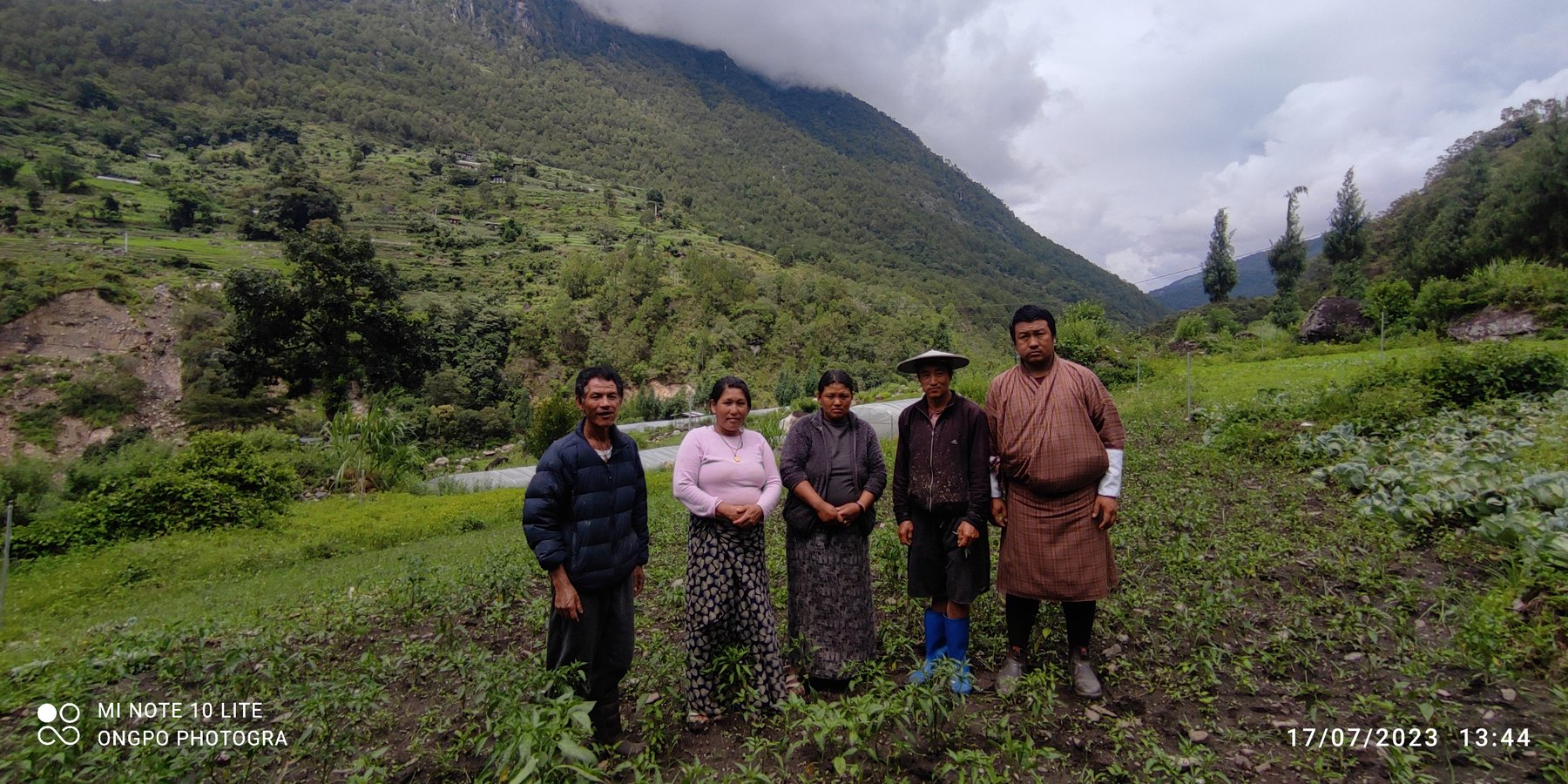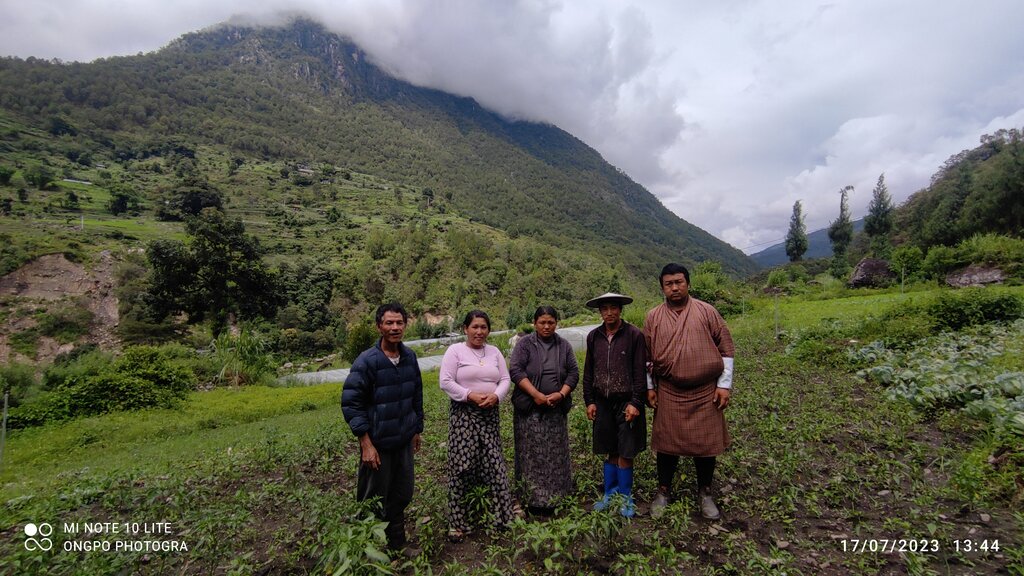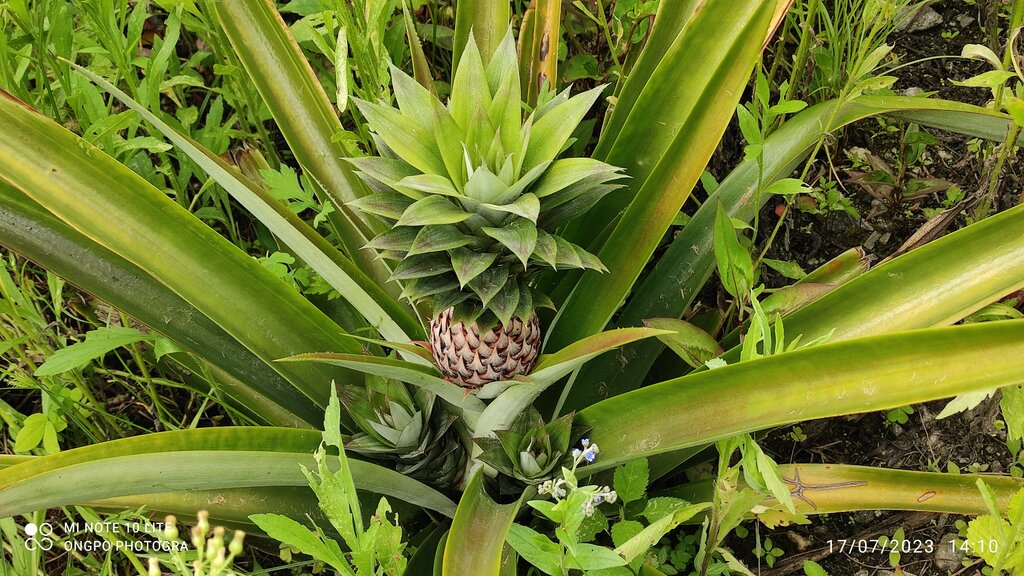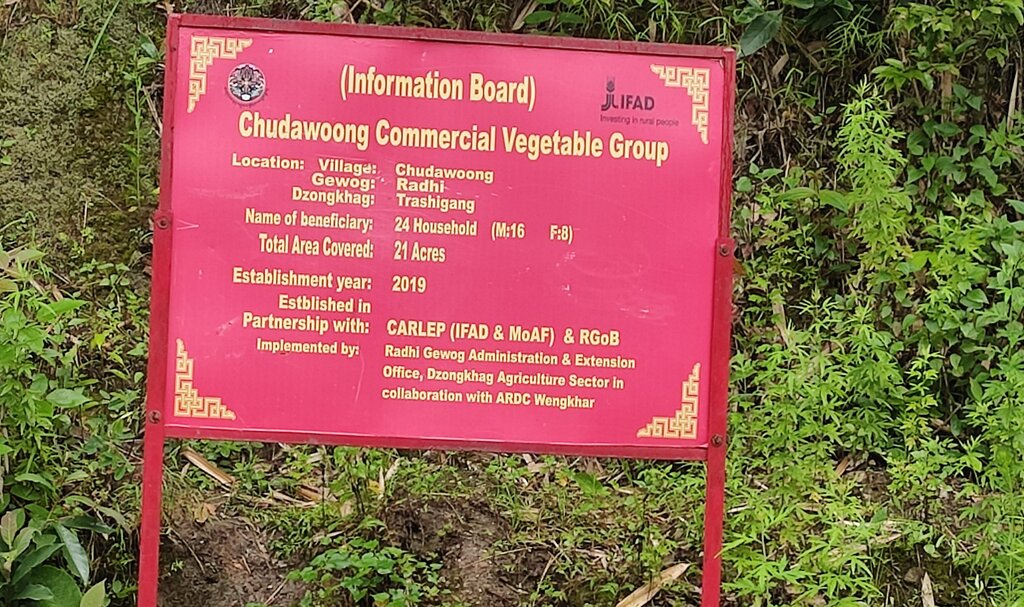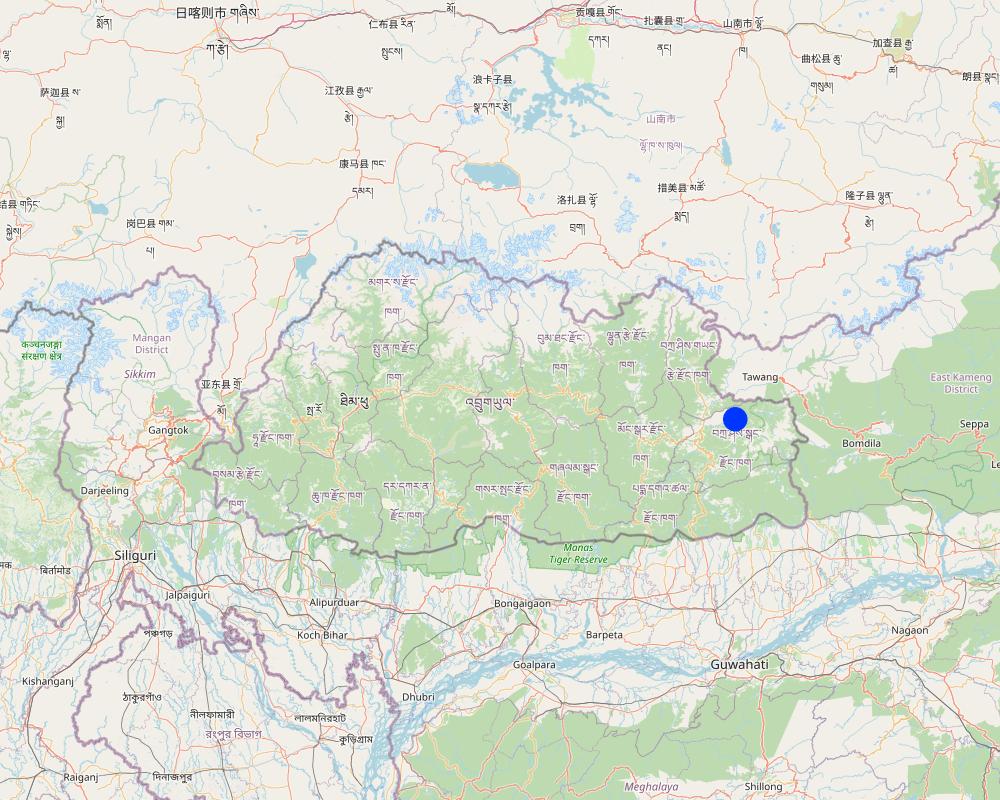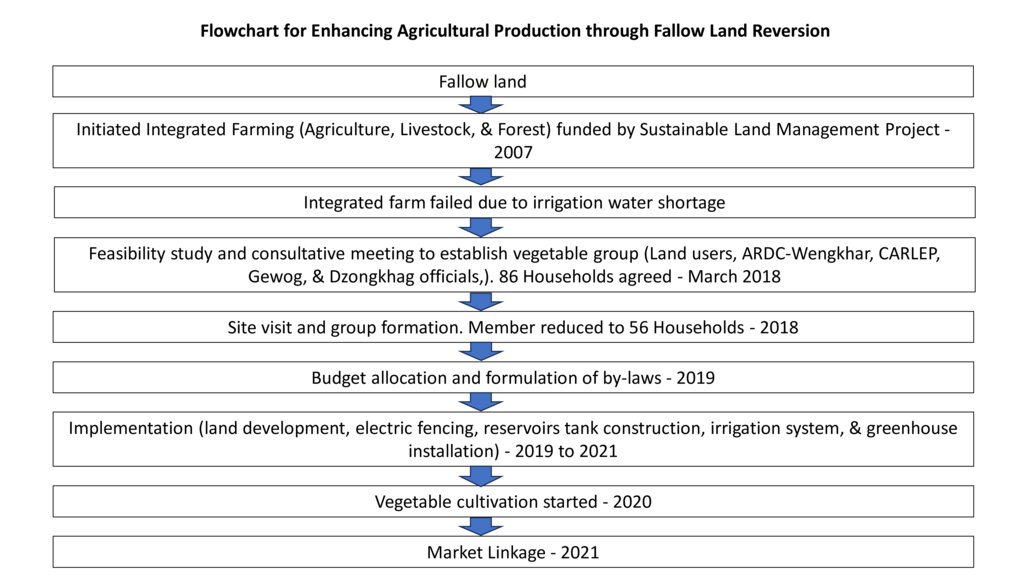Enhancing Agricultural Production Through Fallow Land Reversion [Бутан]
- Создание:
- Обновить:
- Составитель: Nima Dolma Tamang
- Редактор: Tashi Wangdi
- Рецензенты: William Critchley, Rima Mekdaschi Studer, Joana Eichenberger
Zhingtong Zhachoed Baedhi Sanam Thoenshug Yarseng Tangni (ཞིང་སྟོང་ཟ་སྤྱོད་འབད་འདི་སོ་ནམ་ཐོན་ཤུགས་ཡར་སེང་བཏང་ནི།)
approaches_6890 - Бутан
Просмотреть разделы
Развернуть все Свернуть все1. Общая информация
1.2 Контактные данные специалистов и организаций, участвующих в описании и оценке Подхода
Ответственный (-ые) специалист (-ы)
землепользователь:
Yeshey Kinzang
17675628
Pakaling Chiwog, Radhi Gewog, Trashigang Dzongkhag
Бутан
землепользователь:
Jamtsho Ten
17642994
Pakaling Chiwog, Radhi Gewog, Trashigang Dzongkhag
Бутан
землепользователь:
Dendup Pema
77874171
Pakaling Chiwog, Radhi Gewog, Trashigang Dzongkhag
Бутан
землепользователь:
Pelden Tshering
17558529
Pakaling Chiwog, Radhi Gewog, Trashigang Dzongkhag
Бутан
землепользователь:
Zangmo Choni
77753201
Pakaling Chiwog, Radhi Gewog, Trashigang Dzongkhag
Бутан
Agriculture Extension Officer:
Wangchen Pema
17436036
pemawangchen2010@gmail.com
Radhi Gewog, Trashigang Dzongkhag
Бутан
Название проекта, содействовавшего документированию/оценке Подхода (если применимо)
Strengthening national-level institutional and professional capacities of country Parties towards enhanced UNCCD monitoring and reporting – GEF 7 EA Umbrella II (GEF 7 UNCCD Enabling Activities_Umbrella II)Название организации (-ий), содействовавших документированию/оценке Подхода (если применимо)
National Soil Services Centre, Department of Agriculture, Ministry of Agriculture & Livestock (NSSC) - Бутан1.3 Условия, регламентирующие использование собранных ВОКАТ данных
Когда были собраны данные (на местах)?
17/07/2023
Составитель и ответственный/-ые специалист(-ы) согласны с условиями, регламентирующими использование собранных ВОКАТ данных:
Да
1.4 Ссылка (-и) на Анкету (-ы) по Технологиям УЗП
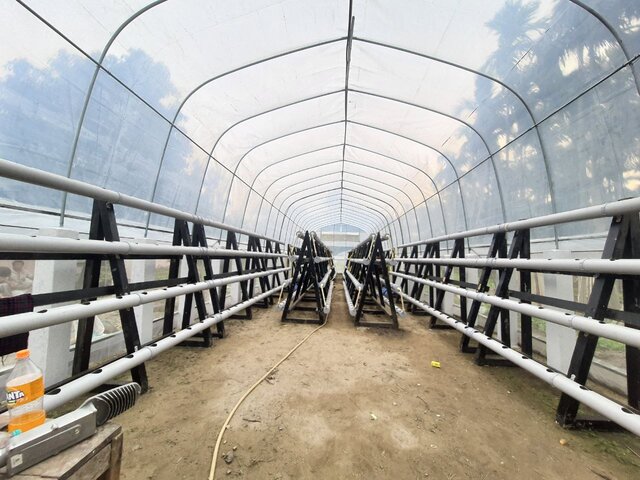
Protected Agriculture for High Value Crops [Бутан]
Protected agriculture (controlled environment agriculture) is the use of technology to modify the growing environment for crops to extend the growing period and increase yields. It can include greenhouses, shade nets or polytunnels. This technology is moderately expensive therefore it is used only for the cultivation of high-value crops and …
- Составитель: Nima Dolma Tamang
2. Описание Подхода УЗП
2.1 Краткое описание Подхода
The approach is to enhance production of local vegetables and fruits through fallow land restoration - under a group established for the purpose.
2.2 Подробное описание Подхода
Подробное описание Подхода:
This approach of reverting fallowed land to productivity encompasses leasing land, working in groups, promoting SLM technologies, and forging market linkages. In this example, the land belongs to the community Lhakang (temple) where the community used to grow maize and pulses to be offered to the Lhakang. However, with increased wild animal depredation, and shortages of irrigation water the land was left fallow. In 2019, with support from the government and the Commercial Agriculture and Resilient Livelihoods Enhancement Program (CARLEP), International Fund for Agriculture Development (IFAD) Project, interested farmers from the community came together, leased the land, and started cultivating vegetables. The reverted fallow land is thus cultivated by the Chuthawoong Commercial Vegetable Farming group which is divided into three subgroups – one of women only - to increase efficiency. The group consist of seven and nine men in two male groups and seven women in one female group. There are no youths involved. The initial development involved the implementation of various SLM technologies such as stone bunding and napier grass strips to reduce soil erosion. Developing market linkages is another characteristic of the approach. The Regional Agricultural Marketing and Cooperatives (RAMCO) linked the land users with three schools to sell vegetables. Furthermore, the group signed a contract with Bhutan Agro Industries Limited (BAIL), Lingmithang (state-owned company) to supply dragon fruit and pineapple for processing.
The main aims and objectives of the approach are to become self-sufficient in vegetables and reduce imports, improve the livelihood and income of the land users and retain youth in agriculture through agricultural mechanization. The methods involved in implementing the approach were consultation among the community leaders and land users, and higher-level consultation with the Gewog Leaders and Dzongkhag Officials, consultation with the Agriculture Research and Development Center (ARDC) Wengkhar and with CARLEP project members.
Stages of implementation included conducting a feasibility study, followed by consultation meetings with the land users. Land development was carried out along with the installation of facilities including fencing, greenhouses, irrigation, and irrigation water storage tanks. After that, the group was formed and bylaws established. Seeds and seedlings were provided by the government.
Stakeholders involved include Gewog officials to develop land lease agreements. The Gewog Extension officer was involved throughout the process in providing guidance and support concerning irrigation, land development, vegetable and fruit cultivation and others. Dzongkhag officials were involved in the feasibility study and planning, and as one of the funding source. CARLEP act as the biggest funding agency to facilitate infrastructure support along with carrying out monitoring activities. ARDC-Wengkhar provided technical support and RAMCO established market linkages.
Land users benefit from increased household income and being self-sufficient in vegetables. The major challenges faced by the land users are distance, as the land is located far away from their houses, and marketing issues, as total production remains above market demand.
2.3 Фотографии, иллюстрирующие Подход
2.5 Страна/ регион/ место, где применялся Подход
Страна:
Бутан
Административная единица (Район/Область):
Trashigang Dzongkhag
Более точная привязка места:
Pakaling Chiwog, Radhi Gewog,
Map
×2.6 Даты начала и окончания реализации Подхода
Год начала реализации:
2017
2.7 Тип Подхода
- недавняя местная инициатива/ инновация
2.8 Каковы цели/ задачи Подхода
The main aim of the approach is to reduce imports by increasing vegetable production, Improve the livelihood and living standard of the land users and retain youth in agriculture through agriculture mechanization.
2.9 Условия содействующие применению Технологии/ Технологий в рамках Подхода или затрудняющие его
Наличие/ доступность финансовых ресурсов и услуг
- содействуют
The approach received financial support from various organizations. Dzongkhag Administration (Royal Government of Bhutan) provided Nu. 500,000/-, followed by Nu. 850,000/- from CARLEP-IFAD project and Nu. 90,000 from BAIL.
Институциональные условия
- содействуют
There is a very good collaboration between the institutions such as Schools and with the BAIL.
Сотрудничество/ координация действий
- содействуют
Although financial support was provided, the community came together to contribute labour for 300 days per household. The farm is Local Organic Assurance System (LOAS) certified and there is a common understanding to follow the organic guidelines.
Нормативно-правовая база (землевладение, права на земле- и водопользование)
- содействуют
The land belongs to the community Lhakang of Pakaling Chiwog. Out of 100 households, only 27 households were interested and engaged in renting the land for crop production. The Local government had facilitated and the lease agreement was drawn between the Lhakhang and community. The land users have to pay a sum of Nu.7500/- to the Lhakang. The group members can cultivate the land for all time while non group members have no right to object or raise any issues. In case, If the group disintegrates in future, any outsider or member of the community can take up the farming activity with no objections from the others.
Осведомленность в области УЗП, доступность технической поддержки
- содействуют
The land users had access to technical support Gewog Extension Officer, the Dzongkhag Agriculture officer and Researchers from the ARDC-Wengkhar.
Рынки (для приобретения материалов и услуг, продажи продукции) и цены
- содействуют
The groups have a linkage to supply vegetables to the schools and signed the contract with the BAIL, Lingmithang
Объем работ, доступность рабочей силы
- затрудняют
The land users are engaged in rice cultivation in their own fields and weaving. Therefore, the availability of manpower in the revived land is minimal.
3. Участие и распределение ролей заинтересованных сторон
3.1 Заинтересованные стороны, участвующие в реализации Подхода и их роли
- местные землепользователи/ местные сообщества
Land users
Contributed labour during the establishment of the farm and involved in the cultivation of the vegetables. They are the main actors in the approach.
- эксперты по УЗП/ сельскому хозяйству
Gewog Extension officer, Dzongkhag Agriculture officer, Researchers from ARDC-Wengkhar.
Provides technical support such as training in vegetable cultivation, and setting up irrigation systems.
- учителя/ преподаватели/ школьники / студенты
Teachers engaged in School Feeding Programme
Purchase farm produce from the group.
- частный сектор
BAIL
Provides fund support and purchase farm produce for processing
- местные власти
Gup, Tshokpa
Involved in developing the land lease agreement.
- государственные власти (отвечающие за планирование или принятие решений)
Royal Government of Bhutan
Conduct a feasibility study, and provide financial support.
- международные организации
CARLEP-IFAD
Provide fund sources for the establishment of the farm and conduct monitoring.
3.2 Участие местных землепользователей/ местных сообществ на разных стадиях реализации Подхода
| Участие местных землепользователей/ местных сообществ | Перечислите участников и опишите их вовлеченность | |
|---|---|---|
| инициирование/ мотивация | самоорганизация | The land was fallow for 27 years and in 2007 the land users tried to restore the land by initiating Integrated Agriculture Farm where they cultivated forest trees, crops and livestock. However, with the unavailability of water, the integrated farm was not successful. People informed the government about the need for a water pump and the Gewog Gup shared it in a higher meeting. This was the initiation of the Land restoration approach. |
| планирование | интерактивное | There were numerous meetings involving the land users, Gewog officials, Gewog Extension Officer, Dzongkhag officials, officials from ARDC-Wengkher and CARLEP. |
| выполнение | интерактивное | Land users and all the stakeholders were involved in the implementation of the approach. |
| мониторинг/ оценка | интерактивное | External monitoring is done by Audit officers from the stakeholders involved, Audit officers from Bumthang for CARLEP, and Audit officers from Samdrup Jongkhar for RGoB. Internal monitoring is done by the Treasurer of the group. |
3.3 Схема реализации (если имеется)
Описание:
The flowchart has been developed in consultation with the land users and Gewog Agriculture Extension Officer.
Автор:
Nima Dolma Tamang
3.4 Принятие решений по выбору Технологии/ Технологий УЗП
Укажите, кто принимал решение по выбору применяемой Технологии/ Технологий:
- все участники как часть процесса совместных действий
Поясните:
All relevant actors were involved in the selection of the technology. Gewog Extension Officer, Dzongkhag Officials, and Researchers from ARDC-Wengkhar provided technical inputs and the land users provided valuable area-specific knowledge based on their experience.
Поясните на чём было основано принятие решений:
- анализ подробно описанного опыта и знаний по УЗП (принятие решений на основе подтвержденных фактов)
- личный опыт и мнения (незадокументированные)
4. Техническая поддержка, повышение компетенций и управление знаниями
4.1 Повышение компетенций/ обучение
Проводилось ли обучение землепользователей/ других заинтересованных лиц?
Да
Укажите, кто проходил обучение:
- землепользователи
Если существенно, укажите гендерный и возрастной состав, статус, этническую принадлежность и т.д.
The training was provided to 7 women and 16 men.
Тип обучения:
- опытные участки
- общие собрания
Рассматриваемые темы:
Soil nutrient management, vegetable production technique, compost making and others.
4.2 Консультационные услуги
Есть ли у землепользователей возможность получать консультации?
Да
Укажите, где именно оказываются консультационные услуги:
- на полях землепользователей
- в постоянно функционирующих центрах
- On social media (WeChat)
Описание/ комментарий:
Advisory service in the form of hands on training at site, at gewog centers and online social media forums such as WeChat.
4.3 Институциональная (организационная) поддержка
В ходе реализации Подхода были ли организованы новые институциональные структуры или поддержаны уже существующие?
- да, умеренно
Укажите уровень, на котором структуры были укреплены или вновь созданы:
- местные
- региональный
Опишите организацию, функции и ответственность, членство и т.д.
The role of the group is to meet their objectives through vegetable production and motivate one another.
Укажите тип поддержки:
- финансовая
- повышение компетенций/ обучение
- оборудование
Подробнее:
The land users benefit from the approach as the income generated is useful in sustaining their livelihoods. Land users' capacity was built as they were engaged in the training and implementation of various SLM technologies. The group received equipment such as an irrigation system, electric fencing, greenhouse and others.
4.4 Мониторинг и оценка
Являются ли мониторинг и оценка частью Подхода?
Да
Комментарии:
The monitoring and evaluation are done by the donors to evaluate the success of the approach. The monitoring includes site visits and verifying the documents on the purchase and sale of the inputs of the produce and its economic benefits to the land users.
Если да, будет ли данный документ использоваться для мониторинга и оценки?
Нет
4.5 Научные исследования
Были ли научные исследования частью Подхода?
Нет
5. Финансирование и внешняя материальная поддержка
5.1 Годовой бюджет мероприятий по УЗП в рамках Подхода
Если точный годовой бюжет неизвестен, укажите примерный диапазон затрат:
- 100 000-1 000 000
Комментарий (например, основные источники финансирования/ ключевые доноры):
CARLEP project and Royal Government of Bhutan
5.2 Финансирование и внешняя материальная поддержка, предоставляемая землепользователям
Предоставлялась ли землепользователям финансовая/ материальная поддержка для применения Технологии /Технологий?
Да
Если да, укажите тип(-ы) поддержки, кто ее предоставил и условия предоставления:
Following are the financial support received by the group. 16 numbers of fabricated greenhouses where the land user paid 20% of the amount and 80% was funded by the donor. 100% funding was provided by the donor for the water pump, electric fencing, internal networking of irrigation, cement, grass-cutting machine, seeds and seedlings, water tank and curing shed construction. Labour input was contributed by the land users. The total of Nu. 90,00,000/- (Ninety hundred thousand) was supported for the project.
5.3 Субсидии на отдельные затраты (включая оплату труда)
- оборудование
| Укажите, какие ресурсы были субсидированы | В какой степени | Опишите субсидии подробнее |
|---|---|---|
| Water pump, grass cutting machine | профинансированы полностью | Water pump and grass cutting machine 100% funded by the doner. |
- сельскохозяйственные
| Укажите, какие ресурсы были субсидированы | В какой степени | Опишите субсидии подробнее |
|---|---|---|
| семена | профинансированы полностью | By RGoB. |
| Land development | профинансированы полностью | 100% machine contribution was done by the government with labour contribution from land users. |
- строительные материалы
| Укажите, какие ресурсы были субсидированы | В какой степени | Опишите субсидии подробнее |
|---|---|---|
| дороги | профинансированы полностью | By government. |
| Greenhouse, electric fencing, internal networking irrigation system, curing shed | профинансированы частично | For greenhouses, 80% was funded by the doner, 20% by land users. For electric fencing, internal networking irrigation system, cement, pipes, curing shed and water storage tank materials were funded 100% by the doner with labour contribution made by land users |
- инфраструктура
| Укажите, какие ресурсы были субсидированы | В какой степени | Опишите субсидии подробнее |
|---|
Если труд землепользователя был существенным вкладом, укажите, был ли этот вклад:
- добровольный
Комментарии:
Labour and locally available materials were contributed by the land users.
5.4 Кредитование
Предоставлялись ли в рамках Подхода кредиты на мероприятия УЗП?
Нет
5.5 Другие методы или инструменты стимулирования
Использовались ли другие методы или инструменты стимулирования для продвижения Технологий УЗП?
Нет
6. Анализ влияния и заключительные положения
6.1 Влияние Подхода
Сумел ли Подход расширить возможности местных землепользователей, повысить участие заинтересованных сторон?
- Нет
- Да, немного
- Да, умеренно
- Да, существенно
The approach improved farm income and their livelihood. It improved stakeholders participation such as schools, Extension officials, and BAIL.
Сумел ли Подход дать возможность принимать решения на основе подтвержденных фактов?
- Нет
- Да, немного
- Да, умеренно
- Да, существенно
The approach enabled land users and the stakeholders involved to make decisions based on the findings. For example, the land users learned that potato cultivation was not profitable due to insect infestation, so they opted for chili cultivation in the next season.
Сумел ли Подход помочь землепользователям внедрить и поддерживать технологии УЗП?
- Нет
- Да, немного
- Да, умеренно
- Да, существенно
Land users implemented stone bunding and napier grass plantation to reduce soil erosion which they have maintained very well as it was very efficient in controlling soil erosion. The Napier grass was also sold creating income opportunities.
Сумел ли Подход расширить знания и возможности землепользователей в применении практик УЗП?
- Нет
- Да, немного
- Да, умеренно
- Да, существенно
The land users were involved in the SLM technologies establishment under the supervision of the SLM specialist leading to improved knowledge.
Сумел ли Подход расширить знания и возможности других заинтересованных сторон?
- Нет
- Да, немного
- Да, умеренно
- Да, существенно
The stakeholders' knowledge was improved greatly as the challenges faced by the land users were forwarded to the stakeholders (SLM specialist/RAMCO). The stakeholders were to address the challenge and in the process, the stakeholder had to develop new techniques and test them on the field which led to improved knowledge of both the parties.
Сумел ли Подход укрепить сотрудничество между заинтересоваными сторонами/ выстроить механизмы сотрудничества?
- Нет
- Да, немного
- Да, умеренно
- Да, существенно
All the stakeholders and land users worked together to achieve a common goal i.e. increased income for land users and use of fallow land for agriculture production, reduce import.
Сумел ли Подход расширить возможности социально и экономически уязвимых групп?
- Нет
- Да, немного
- Да, умеренно
- Да, существенно
If the land users are interested, irrespective of their wealth and status, all the land users in the community are allowed to participate in the approach. Therefore, economically disadvantaged groups involved in farming activity have improved livelihood and increased household income.
Сумел ли Подход содействать гендерному равенству и расширить права и возможности женщин и девочек?
- Нет
- Да, немного
- Да, умеренно
- Да, существенно
The approach has two subgroups with heterogenous members (male and female) and one subgroup has only female members encouraging women's participation in decision-making.
Сумел ли Подход стимулировать молодежь/ будущее поколение землепользователей заниматься УЗП?
- Нет
- Да, немного
- Да, умеренно
- Да, существенно
The approach was initiated to encourage youths to participate in agricultural activities. However, there is no interest shown by the youths. This could be due to low-income generation, poor market access and less or no recreation facility in the approach site.
Сумел ли Подход способствовать улучшению продовольственой безопасности/ качества питания?
- Нет
- Да, немного
- Да, умеренно
- Да, существенно
The approach enabled land users to be self-sufficient in vegetables during winter and also generate income by selling the produce. Thus, making the community self-sufficient in vegetables and certain fruits.
Сумел ли Подход расширить доступ к рынкам?
- Нет
- Да, немного
- Да, умеренно
- Да, существенно
The approach linked the land users to the market such as schools and processing units (BAIL).
Сумел ли Подход привести к созданию новых рабочих мест/ к расширению возможностей получения дохода?
- Нет
- Да, немного
- Да, умеренно
- Да, существенно
The approach improved the income of the land users as they were able to buy school necessities for their children from the income generated by selling vegetables from the approach site.
6.2 Основные причины, побуждающие землепользователей внедрять УЗП
- рост продуктивности
The additional cultivation in the area improved food self-sufficiency and food security. Therefore, increased production due to improved soil quality is one of the main motivating factors to adopt SLM.
- рост прибыли (доходности) и рентабельности
The farmers do not have a significant contribution to the establishment of the SLM, major activities were funded by the government. So all the benefits obtained are profits for the land users. Therefore, this is another important motivation for the adoption of the approach.
6.3 Долгосрочная устойчивость мероприятий в рамках Подхода
Могут ли землепользователи самостоятельно (без внешней поддержки) продолжать применение того, что было реализовано в рамках Подхода?
- да
Если да, опишите как:
The approach is sustainable. Even though the market for large quantities of produce is not available. There is a market linkage created with local consumers. Further, the land users can link with the relevant stakeholders to export the produce. Moreover, the land users were well trained in vegetable production to sustain without external support.
6.4 Сильные стороны/ преимущества Подхода
| Сильные стороны/ преимущества/ возможности по мнению землепользователей |
|---|
| Improved production and increased cultivable land is major strength of the approach. With the fallow land reversion and sufficient irrigation water, the land is is able to produce large amount of crop. |
| The approach contributed to improved household income. By selling the crops grown in the revived area, the land users get additional income to support their livelihood. |
| Сильные стороны/ преимущества/ возможности по мнению составителя или других ключевых специалистов |
|---|
| Improved nutrition to the school children as the quality of organic vegetables supplied by the group is better than the imported produce grown in a conventional system with the use of pesticides especially from India. |
| Reduces import as the group sell their produce to the schools and nearby community. The demand for vegetable is met by domestic production, therefore there are fewer commodities imported. |
6.5 Слабые стороны/ недостатки Подхода и пути их преодоления
| Слабые стороны/ недостатки/ риски по мнению землепользователей | Возможные пути их преодоления/снижения? |
|---|---|
| The land is far from the houses of the land users making it difficult for the land users to give constant management and care. | |
| Radhi is known as the "Rice bowl of eastern Bhutan" and it is also famous for the Bhuray (type of fabric) gho and kira (National dress). Therefore the reverted land is neglected during peak rice production season and labour demanded by the weaving of the Buray gho and kira high. | |
| Due to less market and surplus production. Land users are challenged with marketing of their crops. | Encourage middlemen to purchase their produce and sell it to other parts of the country. |
7. Справочные материалы и ссылки
7.1 Методы сбора/источники информации
- выезды на места, полевые обследования
There were six informants, five land users and one Gewog Extension Officer.
- опросы землепользователей
five land users
- опросы специалистов/экспертов по УЗП
One, gewog extension officer
7.2 Ссылки на опубликованные материалы
Название, автор, год публикации, ISBN:
Lhamo C. (2021). Agricultural production through fallow land reversion with numerous interventions. CARLEP. Retrieved from https://carlep.gov.bt/agricultural-production-through-fallow-land-reversion-with-numerous-interventions/
Где опубликовано? Стоимость?
https://carlep.gov.bt/agricultural-production-through-fallow-land-reversion-with-numerous-interventions/
Ссылки и модули
Развернуть все Свернуть всеСсылки

Protected Agriculture for High Value Crops [Бутан]
Protected agriculture (controlled environment agriculture) is the use of technology to modify the growing environment for crops to extend the growing period and increase yields. It can include greenhouses, shade nets or polytunnels. This technology is moderately expensive therefore it is used only for the cultivation of high-value crops and …
- Составитель: Nima Dolma Tamang
Модули
Нет модулей


